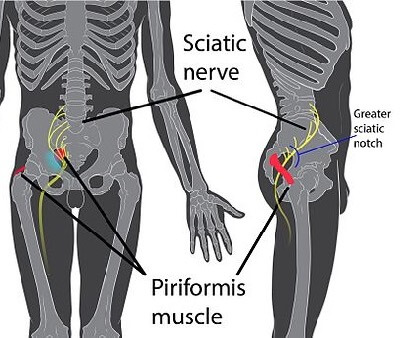- Home
- Benefits of Massage
- Massage for Piriformis Syndrome
As an affiliate with Bookshop, Amazon, and other programs, I may earn revenue from qualifying purchases through affiliate links. This does not affect the price you pay. Privacy Policy / Disclosures. This site is for educational purposes only.
Search this site:
Massage for Piriformis Syndrome Treatment
Pain in your butt and down the back of the leg? You might benefit from massage for piriformis syndrome. This syndrome occurs when a tight piriformis muscle presses on the sciatic nerve and irritates it. This pain is sometimes called false sciatica.

The piriformis (in red) lies under the large gluteus maximus muscle, which is cut away in the illustration.
This article explains more about the condition and provides some
information on massage for piriformis syndrome and tennis ball therapy
for piriformis syndrome.
The Sciatic Nerve
Interesting fact: A common cause of piriformis syndrome in men is sitting on a wallet.
True sciatica is caused by injury to or compression of the sciatic nerve in the lower back due to factors such as degenerative disc disease, slipped disc, pelvic injury, spinal stenosis, or tumors.
In contrast, the cause of piriformis syndrome is a tight muscle pressing on the sciatic nerve. The piriformis is one of the small muscles deep in the buttocks. It helps rotate the leg outwards. One end of the muscle attaches to the sacrum, and the other end attaches to the head of the femur (thigh bone).
The sciatic nerve is the largest nerve in the body and goes from the low back through the buttocks (near the piriformis muscle) and down the legs. In a few people, the nerve goes through the muscle, which press on the nerve and cause pain.
Piriformis Syndrome Explanation:
Piriformis syndrome is easier to treat than true sciatica. You just have to release the tension in the piriformis muscle! (OK, I know that's not always easy.) What can you do?
- Find a massage therapist who knows how to release the muscle. The massage technique often involves pressing deeply into your buttock, but it needs to be done properly to be effective and to avoid making the situation worse. You will likely need more than one massage to permanently resolve the problem.
- Learn some piriformis exercises and stretches. Expert advice is best; beware of some of the videos on the Internet, which may do more harm than good.
- Use the tennis ball massage technique described later in this article.
Massage for Piriformis Syndrome
One approach is to start with superficial effleurage (gliding techniques in Swedish massage) and other general massage techniques to warm and reduce tension in the gluteal muscles, and then use static compression techniques to release myofascial trigger points in the piriformis muscle.
The following video shows one way to use massage for piriformis syndrome:
Tennis Ball Therapy for Piriformis Syndrome
The goal of tennis ball therapy is to release tension in the muscle by applying some pressure. It's sort of a substitute for real massage for piriformis syndrome.
Caution: Do this technique gently; otherwise, it may make the pain worse. To avoid damaging the muscle or nerve, stop immediately if you feel sharp pain.
- Sit on the floor.
- Put a tennis ball under the painful buttock, close to where the piriformis muscle attaches to the upper leg. (Make sure the ball presses into the muscle and not onto bone.)
- Gently release the weight of your buttock into the tennis ball for 15 to 20 seconds.
- Move the tennis ball to another point along the muscle and again let your weight sink into the ball. Apply this pressure along the complete length of the piriformis muscle.
Note: If you find a tennis ball too hard, you can also try a squash ball, which is smaller and softer, or a massage ball.
Photo Credit: Patrick J. Lynch & KDS4444 / CC BY-SA



